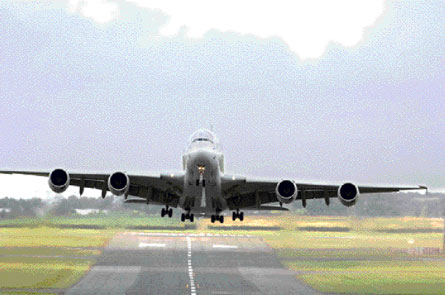Mike Martin reports on how the A380 has shed capacity as countdown to service launch begins.
With the industry now counting the weeks to the Airbus A380’s entry into service, the world’s largest passenger aircraft is undergoing a “world tour” to demonstrate the aircraft’s range capability, airport compatibility and readiness for revenue service.
And as if to reassure airport operators that the A380 won’t be too big for their terminals, Airbus has officially reduced the seat count in the “superjumbo”. Out goes the aircraft manufacturer’s long-held configuration of a 555-seat aircraft, and in comes the aircraft as a 525-seater. Explains director of product marketing Richard Carcaillet. “We were a bit outdated with our 555-seat layout, which had the earlier 1990s standard of business class seat pitch,” he says.

Standard
“Today the business class standard is 60in pitch.” The original configuration for the A380 was 22 first-class seats at 68in pitch, 96 business class seats at 48in pitch and 437 economy class seats at 32in pitch.
Carcaillet says the new configuration in a 525-seat, three-class layout is 10 first class seats, 76 business and 439 economy. The industrial problems that have seriously delayed the delivery of the aircraft have now been overcome, and the first aircraft is due to be delivered to Singapore Airlines (SIA) in October.
According to Mario Heinen, executive vice president, A380 programme, a major reorganisation of the workforce and processes has resulted in getting the production programme in line with promises made to frustrated airline customers. “We have stabilised the industrial process and we are now preparing the industry ramp-up,” he says.
Is there any chance Airbus might be able to speed up the industrial recovery schedule? Heinen says: “This is a dream I have every night. We are ambitious but today we are very much following the recovery plan. There are some opportunities but there is no significant physical improvement I can show today. Next year I might be able to give a different answer.”
With its distinctive blue and gold logo, and the name ‘Singapore Airlines’ stretched across 33 metres of aircraft fuselage, the world's first commercial A380 aircraft (MSN003) rolled out of the paint hangar in Hamburg recently.
Some 100 painters worked over four shifts polishing the 3,100m2 surface area of the aircraft fuselage by hand, and with extraordinary precision. The painting process took 21 days.
The subsequent A380s for Singapore Airlines, MSN005, MSN006 and MSN008, are also in Hamburg and are on track according to the production schedule. In fact, MSN008 is even ahead of schedule, having arrived in Hamburg two weeks earlier than planned. MSN005 is currently undergoing electrical harness installation. This will be followed by systems testing in the summer and cabin furnishing.
Four aircraft for SIA are in Hamburg, including one that arrived two weeks early. In addition, there are now four aircraft in Toulouse destined for Emirates and three for Qantas.
Meanwhile, other A380 aircraft have been continuing a programme of flying the world, the latest mission visiting cities in the Asia/Pacific region.
Non-stop trip
This latest series of flights began with the aircraft departing Paris Charles de Gaulle Airport for a non-stop trip to Tokyo. The flight represented a typical long-range route for A380 airline operators, and it followed the jetliner's first-ever visit to Charles de Gaulle.
Other stops include Sydney, Taipei and New Delhi – its first ever visit to India. The aircraft also visited Mumbai, the headquarters of A380 customer Kingfisher Airlines. There is speculation that the Paris show will be venue for Kingfisher to announce a new order for the world’s largest passenger aircraft.
Huge crowds gathered in and around Indira Gandhi International Airport to watch the A380 do a fly-over, displaying its agility and silent approach before landing.
Earlier, a new series of route proving flights included the first landings in the United States, with A380 MSN 7 making stopovers at New York, Chicago and Washington, DC.
While aviation specialists and citizens of the United States gave the aircraft an enthusiastic welcome, there remains a political undertow of antagonism towards the European manufacturer’s flagship.
Most journalists on the proving flights were suitably impressed by the aircraft. But many are now looking to the next move in the “hard news” side of the saga – the sales performance, which currently stands at 156 firm orders from 14 customers.
Carcaillet says: “I believe there will be more orders from existing customers and there is a strong likelihood of orders from new customers.”
Source: Flight Daily News



















